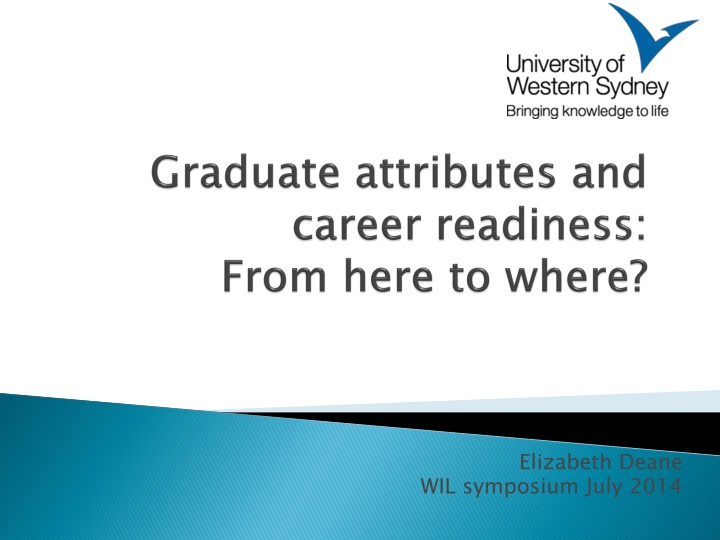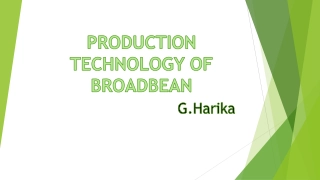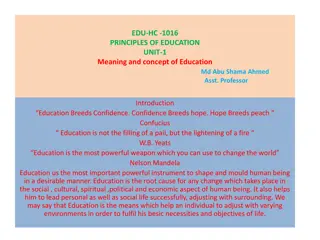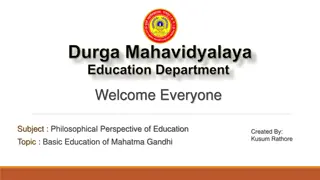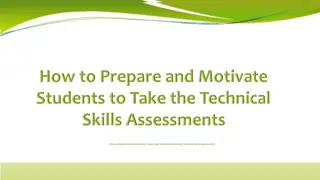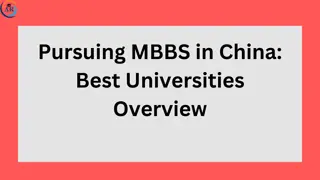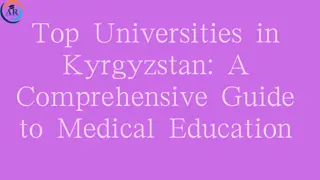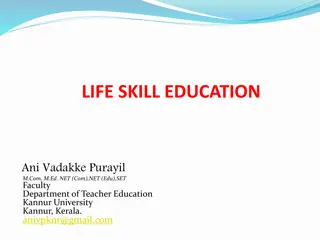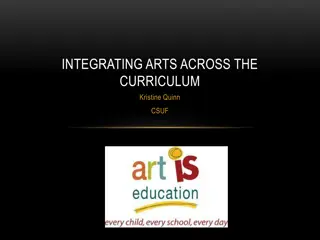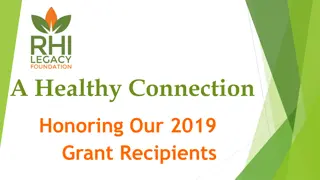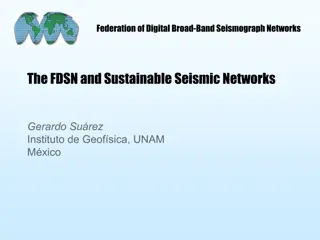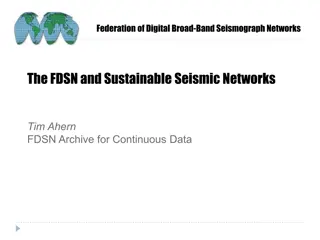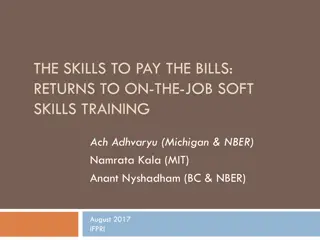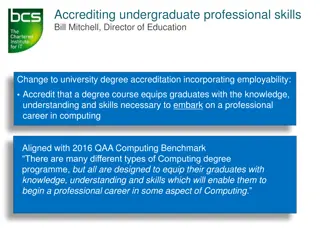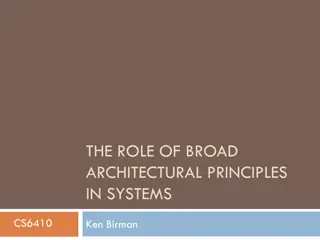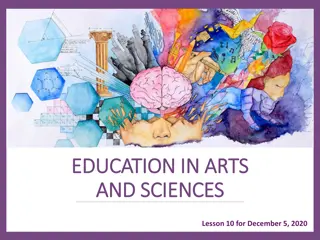Broad Skills in University Education
The content discusses the importance of generic learning outcomes in higher education, focusing on the skills and attributes that universities aim to develop in graduates to enhance employability and competitiveness in the job market. It highlights the regulatory environment, market demands, and the need for effective course design and assessment to meet qualification standards and produce well-rounded individuals with transferable skills for various contexts in life and work.
Download Presentation

Please find below an Image/Link to download the presentation.
The content on the website is provided AS IS for your information and personal use only. It may not be sold, licensed, or shared on other websites without obtaining consent from the author.If you encounter any issues during the download, it is possible that the publisher has removed the file from their server.
You are allowed to download the files provided on this website for personal or commercial use, subject to the condition that they are used lawfully. All files are the property of their respective owners.
The content on the website is provided AS IS for your information and personal use only. It may not be sold, licensed, or shared on other websites without obtaining consent from the author.
E N D
Presentation Transcript
Elizabeth Deane WIL symposium July 2014
One definition: The broad skills that a University expects that graduates will have acquired and be able to demonstrate to an appropriate level whatever their program of study. Are linked to employability skills and program learning outcomes. One definition: An example of how presented: XXX is committed to producing graduates who demonstrate the Graduate Attributes. Students are presented with appropriate learning, teaching, and assessment experiences demonstrate the XXX Graduate Attributes. The XXX Graduate Attributes are explicitly communicated staff and students in all course and unit documentation An example of how presented: learning, teaching, and assessment experiences to enable them to develop and explicitly communicated to course and unit documentation.
Why? (i) The regulatory environment and public accountability The AQF, TEQSA and Professional registration requirements Requires universities to be able to measure and capture information about graduates acquisition of generic learning outcomes as part of their program of study (ii) Competitive employment market Making your graduates stand out (iii) Marketing and positioning Making your University stand out Why? The regulatory environment and public accountability Competitive employment market Marketing and positioning
Learning outcomes for each level and qualification type Knowledge Generic learning outcomes: F Fundamental skills P People skills T Thinking skills and problem solving) P Personal skills integrity). Knowledge, , Skills Skills and and their application their application undamental skills (literacy and numeracy) eople skills (team work and communication skills) hinking skills (learning to learn, decision, making ersonal skills (self direction and acting with
Provider Course Accreditation Standards S1: Course design is appropriate and meets qualification standards S5: Assessment is effective and student learning outcomes are achieved Qualification Standards HE awards are delivered to meet the appropriate criteria Provider Course Accreditation Standards Qualification Standards Graduate Generic learning outcomes: transferable, non-discipline specific skills that a graduate may achieve through learning that have application in study, work and life contexts. Graduate attributes attributes (TEQSA definition)
Apply discipline knowledge, principles and concepts; Think critically, creatively and reflectively; Access, evaluate and synthesise information; Communicate effectively; Use technologies appropriately; Utilise lifelong learning skills; Recognise and apply international perspectives; Demonstrate intercultural awareness and understanding; and Apply professional skills.
Command multiple skills and literacies to enable adaptable lifelong learning Demonstrate knowledge of Indigenous Australia through cultural competency and professional capacity Demonstrate comprehensive, coherent and connected knowledge Apply knowledge through intellectual inquiry in professional or applied contexts Bring knowledge to life through responsible engagement and appreciation of diversity in an evolving world
W We enter the labyrinth! e enter the labyrinth! The world of learning outcomes, constructive alignment and curriculum mapping The world of standards, of benchmarking and moderation The world of graduation statements, ancillary certifications and portfolios
Graduate Attributes must be included on the website; Orientation may include information on the Graduate Attributes; Graduation statement must reference the Graduate Attributes; Unit assessors must inform students explicitly about Graduate Attributes embedded in the Units at the commencement of a Unit and; in the Unit website, Unit learning materials or in classes; in assessment tasks in which a specific Graduate Attribute is assessed.
Course learning outcomes are contextualised using the Graduate Attributes- Course Learning Outcomes Matrix and YY Graduate Attributes Descriptors Table as guides. The Graduate Attributes shall then be mapped across the whole Course curriculum using the Course Learning Outcomes as a guide to ensure a whole-of-Course approach. Each Unit must include at most 3 of the Graduate Attributes explicitly articulated in the Unit learning Outcomes, except, for example, in double weighted Units and Capstone Units which may include more. Each of the Graduate Attributes identified through the Unit Learning Outcomes must be explicitly assessed and included in the marking criteria for the assessment task The interrelationships between the Graduate Attributes, Unit Learning Outcomes and assessment tasks must be displayed for each Unit.
For employers? For accreditation and professional bodies? For Universities? For university staff? For students? Have we ever asked? Have we ever asked?
Shifting the focus to Students 1. Student reflection's on attainment 2. Personal development portfolios Reality checks 1. Capstones 2. Workplace embedded projects Shifting the focus to Students Reality checks
A structured and supported process by which students reflect upon their own learning, performance and/or achievement. Aims to provide support for students in planning their personal, educational and career development Students can identify goals for the future and record their achievements and skills development Mandatory in UK HE Mandatory in UK HE
Specific tools which allow students to step through a reflective assessment process: Example 1 (ACEN MQ) Pre-activity self-rating Evidence gathering, collation and presentation Post activity self rating Reflection and analysis guided by prompts Example 2 (Liverpool UK/Griffith tool kit) Online self assessment tools (https://www.ljmu.ac.uk/studentex/studentex_docs/Grad uate_Skills_Diagnostic_13.html) http://www.griffith.edu.au/__data/assets/pdf_file/0009/2 90817/Professional-skills.pdf Example 1 (ACEN MQ) Example 2 (Liverpool UK/Griffith tool kit)
H Helps students Synthesise their learning across the program; Demonstrate holistically their development of graduate capabilities; Successfully negotiate the transition to work Enables the institution: To assess final graduate capabilities from a program of study. design and assessment pivotal elps students: Enables the institution: design and assessment pivotal
Work integrated learning Structured and purposefully designed learning and assessment activities Integrates theory with the practice of work. Allows students to learn, apply and demonstrate skills and knowledge applicable to the course of study being undertaken Students interact with industry and community within a work context or similar situation, includes service learning
UWS has the heres and many of wheres? WIL is alive and well. Can we do more? Increase our community and industry connectedness? Some programs have capstones should we have more? How much self reflection occurs? How much non- program based credentialing do we do? Can we do better?
